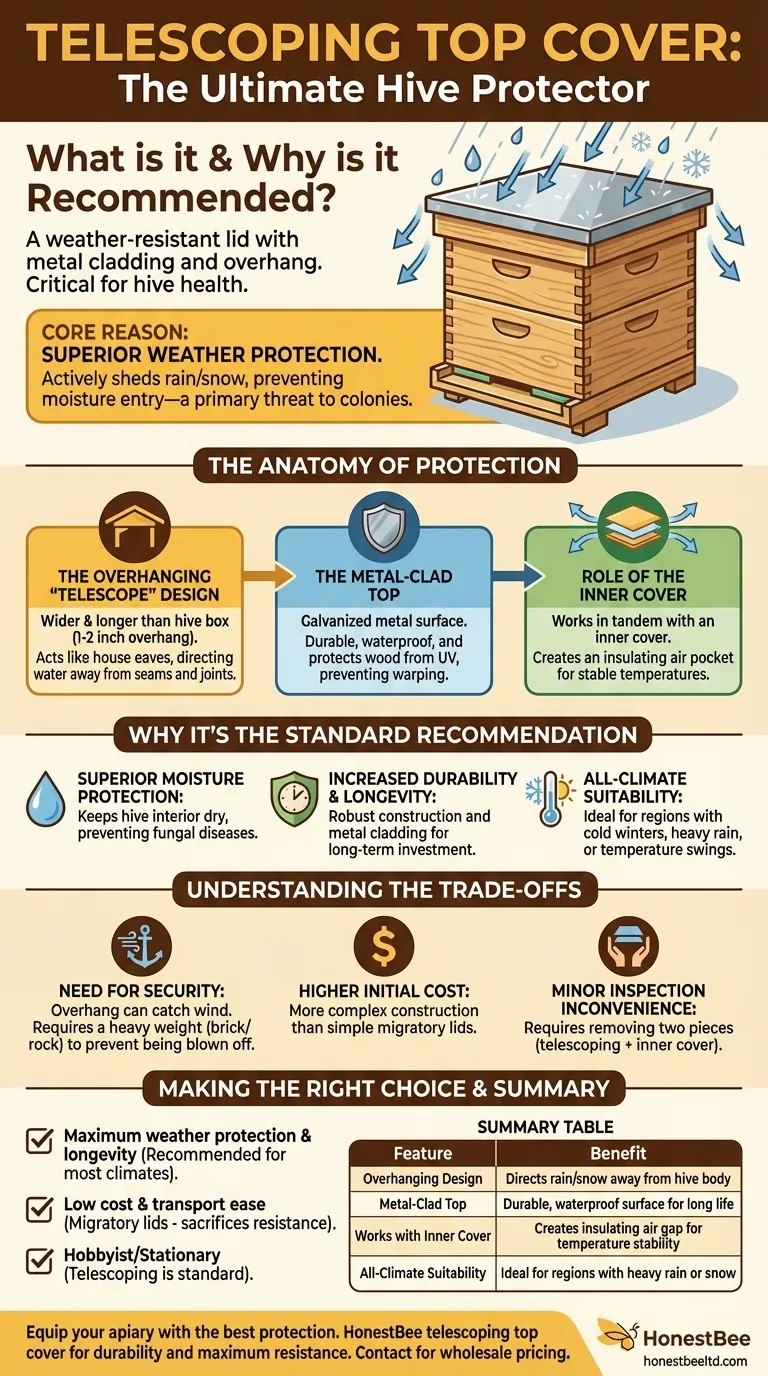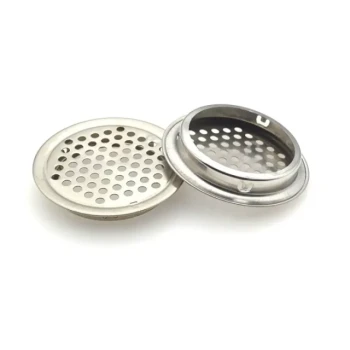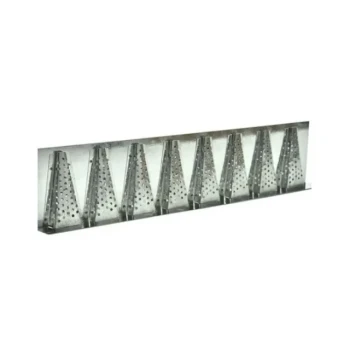A telescoping top cover is a protective, weather-resistant lid for a Langstroth beehive that overhangs the top hive box. It is constructed from wood and topped with a sheet of metal, a design feature that is critical for its primary function. This cover works in tandem with an inner cover to provide a robust barrier against the elements.
The core reason the telescoping top cover is recommended is its superior design for weather protection. Its overhanging edges and metal top actively shed rain and snow, preventing moisture from entering the hive, which is one of the most significant threats to a colony's health.

The Anatomy of Protection
To understand why this cover is so effective, you must understand its key design components and how they work together.
The Overhanging "Telescope" Design
The defining feature is its "telescoping" nature—the cover is wider and longer than the hive box itself. This creates a 1- to 2-inch overhang around the top of the hive.
This overhang acts like the eaves on a house, directing rainwater away from the hive's seams and joints. Without it, water could run down the side of the hive and seep into cracks, promoting rot and mold.
The Metal-Clad Top
The top surface is covered with a thin layer of galvanized metal. This provides a durable, waterproof surface that allows water and melting snow to run off easily.
The metal also protects the underlying wood from direct sun and UV exposure, preventing it from warping, cracking, and deteriorating over time.
The Role of the Inner Cover
A telescoping top cover is designed to be used with an inner cover. The telescoping cover rests on the edges of this inner piece.
This creates a crucial pocket of dead air space between the two covers. This air gap provides excellent insulation, helping the bees maintain a stable internal temperature during both hot summers and cold winters. It also prevents the bees from gluing the main top cover to the hive box with propolis.
Why It's the Standard Recommendation
The specific design of the telescoping cover directly translates into tangible benefits for hive health and management, making it the default choice for most beekeepers.
Superior Moisture Protection
The combination of the metal top and overhanging sides makes this cover exceptionally effective at keeping the hive interior dry. A dry hive is essential for preventing fungal diseases and reducing winter stress on the colony.
Increased Durability and Longevity
While more expensive than simpler migratory lids, the robust construction and metal cladding mean a telescoping cover will last for many years. It is an investment in the long-term protection of your equipment and your bees.
All-Climate Suitability
Its weather-resistant properties make it the ideal choice for beekeepers in regions with cold, snowy winters or heavy rainfall. The enhanced protection is critical for colony survival in challenging climates.
Understanding the Trade-offs
While highly recommended, the telescoping cover is not without its considerations. Objectivity requires acknowledging its specific operational requirements and cost.
The Need for Security
Because the cover overhangs the hive, it can catch strong winds like a sail. It is standard and necessary practice to place a heavy weight, such as a brick or a large rock, on top to prevent it from being blown off.
An unsecured cover can be dislodged during a storm, leaving the colony completely exposed to rain and cold, which can be catastrophic.
Higher Initial Cost
A telescoping top cover is more complex to manufacture than a simple flat lid. This results in a higher upfront cost compared to alternatives like a migratory cover, which sits flush with the hive body.
Minor Inspection Inconvenience
Hive inspections require removing two pieces (the telescoping cover and the inner cover) rather than just one. This is a very minor inconvenience but a difference in handling compared to simpler lids.
Making the Right Choice for Your Hive
Your choice of cover should align directly with your climate and beekeeping goals.
- If your primary focus is maximum weather protection and hive longevity: The telescoping top cover is the definitive choice, especially in regions with significant rain, snow, or temperature swings.
- If your primary focus is low cost and ease of transport for migratory beekeeping: A simpler, flush-fitting migratory lid may be used, but you will sacrifice significant weather resistance and durability.
- If you are a hobbyist or stationary beekeeper in any climate: Starting with the telescoping top cover is the standard, recommended practice for ensuring the best possible protection for your colony.
Ultimately, choosing the right cover is a foundational decision in providing a safe, dry, and stable home for your bees.
Summary Table:
| Feature | Benefit |
|---|---|
| Overhanging Design | Directs rain/snow away from hive body |
| Metal-Clad Top | Durable, waterproof surface for long life |
| Works with Inner Cover | Creates insulating air gap for temperature stability |
| All-Climate Suitability | Ideal for regions with heavy rain or snow |
Equip your apiary with the best protection available. The HONESTBEE telescoping top cover is built for commercial beekeepers and distributors who demand durability and maximum weather resistance for their Langstroth hives. Ensure your colonies stay dry and healthy season after season. Contact HONESTBEE today for wholesale pricing on this essential beekeeping equipment.
Visual Guide

Related Products
- Professional Insulated Winter Hive Wrap for Beekeeping
- Professional Drop-Style Hive Handles for Beekeeping
- Inner Beehive Cover for Beekeeping Bee Hive Inner Cover
- Stainless Steel Round Beehive Air Vents for Ventilation
- Endless Loop Ratchet Hive Strap
People Also Ask
- How does insulation help bee hives in severely cold weather? Conserve Energy & Ensure Colony Survival
- What is the advantage of an insulated outer cover? Boost Winter Survival & Spring Buildup
- What are the durability features of Bee Blankets? Built to Last in Demanding Apiary Conditions
- Why is insulation important for hives during winter? Ensure Your Bees Survive and Thrive
- What are the steps to properly wrap a beehive for winter? Ensure Your Colony Survives the Cold



















